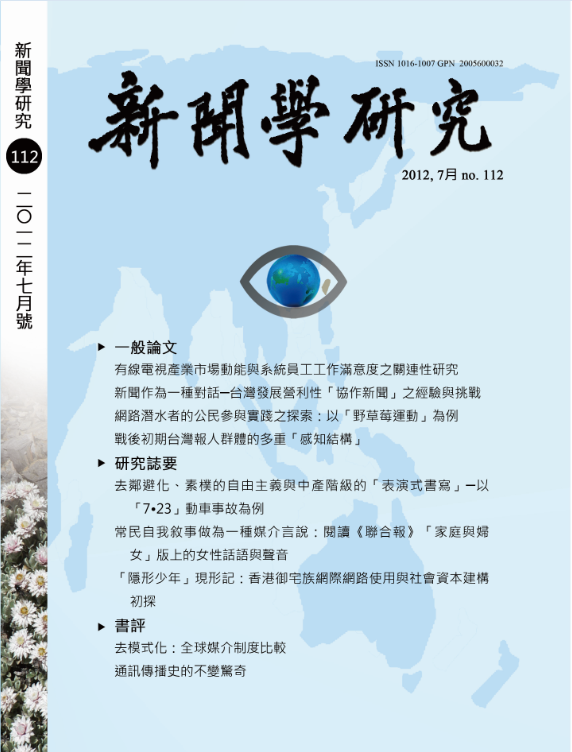前期出版
前期出版
頁數:117﹣158
戰後初期台灣報人群體的多重「感知結構」
The Multiple “Structures of feeling” of Taiwan Newspapermen during the Early Postwar Years
研究論文
作者(中)
邱家宜
作者(英)
Eve Chiu
關鍵詞(中)
新聞學研究,政大
關鍵詞(英)
identity, Lei Zhen, Li Wan-ju, structure of feeling, Wu Cho-liu, Zeng Xu-bai
中文摘要
解嚴以來,國家認同的分歧一直是台灣社會內部緊張的最大來源,新聞媒體的立場在統獨議題上隔空對陣、壁壘分明,欲探究這個現象,必須回到戰後台灣的歷史過程中去尋找原因。本論文選擇吳濁流、李萬居、雷震、曾虛白四位報人,嘗試抽繹其各自不同的「感知結構」,做為理解其認同歸屬的基礎。而不論是影響力迄今未衰的曾式「感知結構」、強調台灣主體意識的吳式「感知結構」,或兼及本土草根情懷與中華文化幽思的李式「感知結構」,以及伸張言論自由、民主程序正義的雷式「感知結構」,目前正同時顯現於當今的台灣社會,也同時都是台灣新聞媒體工作者所承繼的文化遺產,並成為構築下一波新興「感知結構」的重要質素。
英文摘要
The diversity of national identity has been a major cause of domestic tension in Taiwanese society. The news media’s divided opinions on the issues of Taiwanese independence tear society apart. For a sensible interpretation of this phenomenon, we must look back to the post-war period in Taiwan to identify the roots of these various identities. This paper chooses four newspaper journalists: Wu Cho-liu, Li Wan-ju, Lei Zhen, and Zeng Xu-bai, and analyzes their individual “structures of feeling” as the basis for understanding their distinct identities. No matter the keeping working Zhen type “structure of feeling”, the Taiwan subjectivity emphasized Wu type “structure of feeling”, both grass-roots and mainland China related Lee type “structure of feeling”, or the democracy and freedom of speech searching Lei type “structure of feeling” are all part of the cultural heritage of Taiwan news media workers and will become essential material for the coming new “structure of feeling”.
462次下載



